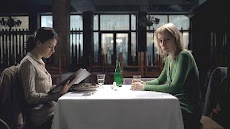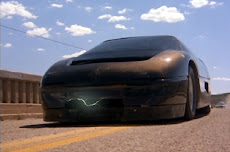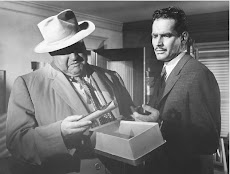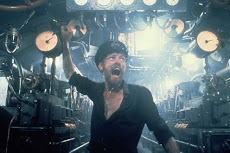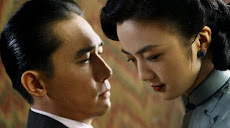skip to main |
skip to sidebar
Drawing on my Blade Runner post a few weeks back, one reason the Special Edition Uber Box Set release is cherished by fans is because it includes every popular edition of the film as well as the "Workprint," which was seen only by some very lucky theater-goers (and those who bought a bootleg off one of them) until that point. Even though the DVD with the original Domestic Cut includes a short introduction by Ridley Scott officially disowning the version and saying it's included solely for the fans, at least he respects the fans enough to include it.Paging George Lucas?This weekend I had the almost-pleasure to view The Empire Strikes Back on DVD. Never mind that this DVD box set came out in 2004, this was my first viewing. The results give me pause. This is not news, but Lucasfilm tweaked (or, changed) Empire and its fellow originals to fix continuity issues with the new Star Wars trilogy. Again, this is not news-- see the full story of changes here. Basically, Lucasfilm's Empire Strikes Back now includes a re-do of Darth Vader's communication with Emperor Palpatine from his flagship, Executor via hologram. They used Ian McDiarmid (the actor who played Palpatine in Return of the Jedi and the three prequels) and changed the dialogue:  (Decidedly, no longer a woman with creepy superimposed eyes.)
(Decidedly, no longer a woman with creepy superimposed eyes.)This I could handle even though it made me think of the three newer movies, which I can't stand. Far worse--unforgivable, I daresay--is the re-dubbing of Boba Fett's voice. This was also done to bring the entire trilogy in line with Attack of the Clones (Episode 2), which I still haven't actually seen (and likely will not). Anyway, Fett used to sound mean and gruff, and now he sounds like a drunken Cockney tough guy-- oh, all right, he sounds like Temuera Morrison, who played Jango Fett in Clones. Make that "drunken New Zealand tough guy." I proudly own a Star Wars box set from around 1995, VHS tapes which include the original trilogy "Digitally mastered in THX." Sadly, it's pan-and-scan format, but aside from this and THX restoration it's exactly what the fans saw in 1977, 1980, and 1983, respectively. Does even the new (2006 / 2008) Star Wars box set-- the release of the original trilogy since 1995--treat the originals like the Blade Runner set? Alas, no. Look no further than the user comments on Amazon regarding the recent 2008 release to get the story.As an aspiring esquire with very limited knowledge of copyright law who considered actually writing a law review article on the subject, I can say that Lucas is well within his rights to do whatever he wants with his trilogy, be it with the content or the release format. Nevertheless, I join legions of fans who are dismayed that with all of its money Lucasfilm refuses to prefectly restore the original trilogy, release it in anamorphic widescreen and, while they're at it, put it out on BluRay. I can't speak for the law, but the public policy implications are ripe. This appears to be an issue of first impression. We've seen boatloads of "Director's Cuts" and "Special Editions" for over 20 years now (before the home video releases many films, including Fried Green Tomatoes, featured television premieres hyped with "scenes not seen in theaters"); we now have separate releases of "rated" and "unrated" films, some even combined to include both versions on one disc. The (original-)original Star Wars trilogy appears to be, for the moment, the lone victim of suppression. Of course Lucas can't do anything about my VHS tapes or the old laserdiscs-- this isn't really suppression--he can simply refuse to heed fans' demands for perfection, which is well within his rights. I have a feeling, though, that there's a good argument here for abandonment. Lucas has altered his property, but the original is still there, in the beautiful form he gave fans over twenty years ago. Is there not an argument that this is, in fact, "Cultural Property?" It would be a new frontier; Cultural Property is currently limited to artifacts, monuments, and other artworks (think the Sphinx). This would place the originals in public domain and open the door for other users to get the negative, restore it to better-than-original glory, and make it available to the public.
All right, the capitalists (me included) may break out in hives at the thought, but it seems so, so perverse that I'm willing to make my stand in spite of all slippery slope arguments.
You don't want your kids growing up with Boba Fett from New Zealand, do you?
Apologies for the lack of a post over the past few weeks. To begin, it's nice to review a new film for a change. While I haven't made it to critics-only pre-screenings yet, at least I caught Watchmen during opening weekend.With this, Zack Snyder can, perhaps, join our directorial hat-trick list, slotting in this #3 on the heels of 300 (2006) and Dawn of the Dead (2004). This is a very respectable list, especially notable because all three films originate from well-regarded source material. Dawn of the Dead is a remake of George Romero's 1978 follow-up to his own classic Night of the Living Dead (1968) (catch all that?). Considering Romero's own protege Tom Savini couldn't successfully remake Night (1990), to pull off Dawn as well as Snyder did (on top of it being Snyder's first feature film) was almost miraculous. While Sin City (2005) was well done and certainly star-studded, it hasn't enjoyed the staying power of 300, Snyder's first foray into not just comic books, but comic books from one of the masters, Frank Miller.
 After reading the Watchmen graphic novel (read: a 12 comic book series bound into one volume) for the first time just last June, when the trailer for the film dropped with The Dark Knight over the summer I was enthused, but anxious. Watchmen is the most influential comic book ever created. (I highly recommend The Dark Knight Returns and the first 12 issues of American Flagg! as well, but I digress.) Its narrative, complexity and delightful tangents are, taken as a whole, nothing short of intimidating (but in a good way). Snyder is a gifted director, but when directors none other than Terry Gilliam (no slouch when it comes to difficult adaptations) have judged a work "unfilmable," it's no insult to suspect he may have bit off more than he could chew.
After reading the Watchmen graphic novel (read: a 12 comic book series bound into one volume) for the first time just last June, when the trailer for the film dropped with The Dark Knight over the summer I was enthused, but anxious. Watchmen is the most influential comic book ever created. (I highly recommend The Dark Knight Returns and the first 12 issues of American Flagg! as well, but I digress.) Its narrative, complexity and delightful tangents are, taken as a whole, nothing short of intimidating (but in a good way). Snyder is a gifted director, but when directors none other than Terry Gilliam (no slouch when it comes to difficult adaptations) have judged a work "unfilmable," it's no insult to suspect he may have bit off more than he could chew.
Thankfully, my fears did not come true. Entirely.
As a director, once again Snyder has proved his worth. He has taken a classic and translated it seamlessly to the big screen. I will not be slobbering all over this film; I do have reservations, but it is a noble cinematic effort which I believe deserves far more praise than popcorn fare like The Dark Knight.
At 163 minutes this is a long film, but it only misses its pace on a few occasions. Having seen the film after reading the novel, I knew what was coming and looked forward to it, and was most often impressed with the execution. If only for purposes of time, rewrites, and subtractions and additions to dialogue were necessary, and mostly well-done. Joe Morgenstern's review in the Wall Street Journal rightfully blasts some lines such as "I'm not a comic-book villain," but I daresay he's nitpicking. The action is intense, however quite graphic (another trademark for all three of Snyder's feature films), but interesting and well-choreographed. I believed for a time after Matrix Reloaded that Hollywood had completely lost it with fight scenes, but with Watchmen and 300 Snyder's ensured they're alive and well. The mis en scene is outstanding, and I have nothing but respect for the costume designers, set designers and other assorted crew who put this together.
The acting varies. Fortunately, Jackie Earle Haley is perfect as Rorschach, arguably the story's main character. Especially when he's unmasked, Haley brings to life a very disturbed man who, while I don't want to be his friend, draws some respect for his uncompromising nature. Billy Crudup is almost as good as Dr. Manhattan, but in his more sensitive moments I couldn't help but think of Tobey Maguire as Peter Parker, Spider-Man's civilian side. Patrick Wilson is good as Nite Owl, but he shares many scenes with Malin Akerman who, I'm sorry to say, has a ways to go.
Snyder's, and the film's, boldest trademark is Snyder's fearless use of popular music. This should be no surprise: for the opening credits of Dawn of the Dead he selected "The Man Comes Around" by Johnny Cash, and it's amazing. In Watchmen, we're treated to Simon & Garfunkel, Jimmi Hendrix, Bob Dylan, etc., and all to great effect.
I cap the good aspects of this film with the music because it's one of the few things that truly separates Watchmen from its source material. Floating at a meager score of 56/100 on metacritic at the time of this post, this is the quandary many critics, myself included, face with the film: why? Is there a point where a translation is done so effectively that it becomes meaningless or even insulting? Of course, there's no satisfying the entire audience: too much creative license would have drawn equally (if not more) powerful wrath from those crying "sacrilege!" But this only dodges the question.
To be sure, Watchmen is treading into charted but not-as-of-yet mastered territory: parallel media. The comic is so dense with material, nothing short of a 13-hour mini-series would have brought it all to the screen. So, soon enough we'll have an animated version of Tales of the Black Freighter to supplement the film. Tales is an excellent parallel narrative in the comic. This kind of multi-pronged storytelling hasn't worked out well thus far: Star Wars: The Clone Wars opened in theaters last year to launch a television series without much success. Far less successfully, though, Richard Kelly's disaster Southland Tales is actually the last three chapters in a six-chapter story, the first three chapters being comic books very few people purchased (guilty). But where these films were producing fresh material in various forms, Watchmen seeks to preserve an old story in a new form. David Edelstein may be right: "This kind of reverence kills what it seeks to preserve."
This nagging feeling combines with my biggest critique of Watchmen as a film and as a graphic novel. For all of the criticism that may be directed toward the film, it strikes me that the heavy-handedness, the "there is no hope" message of Watchmen is rather over-the-top. To be sure, Rorschach (and, perhaps, all his "reactionary" faults?) has the last laugh, but this seems to pale in light of the story's climax. Both Tales of the Black Freighter and the main narrative in Watchmen give off disturbing support of... well, inaction? We have two stories which show that the pursuance of good, or the best intentions, can be corrupted with evil means. This is a tragedy as old as man, but the film and the novel alike seem to sigh at this with an all-encompassing "oh, well." Whether one fights evil means uncompromisingly as Rorschach does or pursues good ends with those evil means as Ozymandias, it seems that "All's Well that Ends Well." Sure, there's a glimmer of humor and hope in the closing of the story, but is this a little too little too late?
Unlike No Country for Old Men, a film and book with dastardliness I defend as a call to arms, Watchmen ultimately strikes me with a call to do nothing: if greater forces are at work, there's no stopping them. I won't settle for this.
In conclusion, I suppose I've learned in this post why I'd never make for a good movie reviewer on the clock: I need time to digest this stuff. Often, lots of it. Blade Runner, that film I gave a whole post to a few weeks back? I hated it the first time I saw it. Perhaps someday I'll have some conclusions for all the questions I've raised with Watchmen. But, indeed, while I have plenty of criticism to level at it, Watchmen is a very thought-provoking and expertly executed film that I encourage moviegoers to see.
I'll end almost as I began: this isn't The Dark Knight, and I mean that as a compliment.


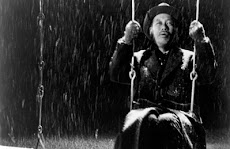

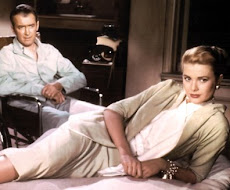_01.jpg)
